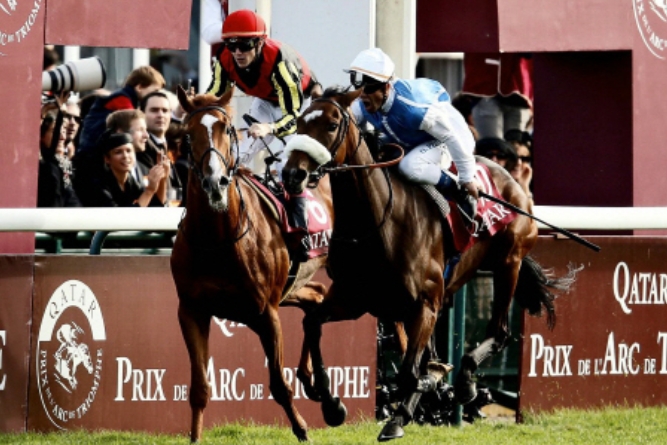Orfevre is not your typical champion racehorse.
While many great horses are defined by their flawless form or consistent temperament, Orfevre captivated fans by being wildly unpredictable — and fiercely brilliant. A striking chestnut colt born in 2008, he quickly rose to stardom by claiming the Japanese Triple Crown in 2011, becoming only the seventh horse in history to do so. But it wasn’t just the victories that defined him — it was how he won, how he lost, and how he made every race feel like a story.
Known for his explosive acceleration and occasionally erratic behavior, Orfevre was a genius on the track and a puzzle to his handlers. He would unleash devastating finishes one moment, and veer off course the next. Yet despite — or perhaps because of — his quirks, Orfevre came within inches of claiming one of horse racing’s most elusive prizes: the Prix de l’Arc de Triomphe.
Even in defeat, he inspired awe. His second-place finishes in the Arc (2012 and 2013) left the global racing world stunned and sparked a new wave of respect for Japanese horses on the international stage.
Today, Orfevre’s legacy lives on — not only through highlight reels and fan tributes, but through his offspring, many of whom are now making their own marks in racing.
In this article, we take a deep dive into the life, brilliance, and legacy of one of Japan’s most unforgettable racehorses: Orfevre, the untamed genius of the turf.
Early Life and Pedigree
Bred for Greatness: Bloodline of Champions
Orfevre was born with racing royalty in his veins. His sire, Stay Gold, was a late-blooming champion who proved his talent with a G1 win overseas and came from the Sunday Silence line, the most dominant bloodline in Japanese racing history. On his dam’s side, Orfevre inherited the grit and stamina of Mejiro McQueen, a two-time Tenno Sho (Spring) winner known for his power over long distances.
More than just genes, Orfevre also carried expectations. He was the full brother of Dream Journey, a three-time G1 winner whose success raised hopes for his younger sibling. But Orfevre would not simply meet expectations — he would surpass them in dramatic fashion.
A Stormy Temperament Hiding Genius
From his earliest days, Orfevre showed that he was no ordinary horse. Trainers quickly realized he had both brilliance and volatility. He was intelligent and athletic — but also unpredictable. In his debut race, he won easily, only to throw off his jockey in the winner’s circle. Such behavior became part of his legend.
His temperament, while challenging, didn’t overshadow his raw talent. His stride was smooth, his turn of foot devastating, and his racing instinct razor-sharp. He was a horse who could switch gears instantly — but also one who could lose focus in a flash. In many ways, Orfevre was born not only with the blood of champions, but the heart of a rebel. And that made him unforgettable.
The Meteoric Rise: From Trial to Triple Crown
A Rocky Start with Glimpses of Brilliance
Orfevre’s rise to fame was anything but smooth. After winning his debut race in 2010, he struggled to stay consistent. His raw talent was evident, but so were his behavioral quirks. He was prone to sudden outbursts, mental lapses, and unpredictable performances — traits that kept trainers and bettors guessing.
Still, flashes of brilliance hinted at what was possible. In March 2011, he claimed his first graded victory in the Spring Stakes (G2), showing a newfound maturity. That race became the turning point. From there, Orfevre’s form tightened, and the once-erratic colt began to evolve into a true competitor.
Sweeping the Classics: Satsuki Sho, Japanese Derby, and Kikuka Sho
In the spring of 2011, Orfevre stormed into the spotlight with a dominant win in the Satsuki Sho (Japanese 2000 Guineas), then followed it up by conquering the Tokyo Yushun (Japanese Derby) over heavy ground — proving he could win under pressure, even in adversity.
By autumn, he completed the historic sweep with a powerful victory in the Kikuka Sho (Japanese St. Leger), becoming only the seventh horse in Japanese racing history to win the Triple Crown. Each race showcased a different side of Orfevre — versatility, resilience, and breathtaking speed.
The Arc That Got Away: European Campaign
Heartbreak in Paris: The 2012 Prix de l’Arc de Triomphe
In 2012, Orfevre took on the ultimate international challenge — the Prix de l’Arc de Triomphe in France. Japanese racing fans had long dreamed of winning this race, and Orfevre seemed like the horse who could finally do it. After a dominant prep win in the Prix Foy, he entered the Arc as one of the top contenders.
On race day, everything appeared to go perfectly. Orfevre surged through the field with explosive power, took the lead in the final 300 meters, and looked destined for history. But in a shocking twist, he suddenly veered toward the inside rail and lost momentum. In the final strides, Solemia passed him. Orfevre finished second — not because he was outclassed, but because he beat himself.

2013: Another Arc, Another Agonizing Second
Determined to finish the job, Orfevre returned to France in 2013. This time, he was more mature, his training was tailored for the Arc, and his team was laser-focused. He again won the Prix Foy with ease and lined up for the Arc with global expectations on his back.
But history repeated itself — this time more brutally. He delivered a strong run, but Treve, an undefeated filly and future legend, unleashed a devastating late kick and won by five lengths. Orfevre once again finished second. Two Arcs, two near misses. Yet, these defeats didn’t diminish his greatness. If anything, they made his legend richer — a horse good enough to win the world, but just wild enough to fall short.
Defining Races That Shaped His Legend
The Wild 2012 Hanshin Daishoten
Among Orfevre’s most unforgettable races was the 2012 Hanshin Daishoten — not for a win, but for a near disaster. In his seasonal debut, he fought against his jockey’s control, refused to make the turn at the final corner, and nearly bolted off the course. Fans gasped, fearing injury or disqualification.
Yet somehow, after losing multiple lengths and falling far behind, Orfevre re-engaged, surged down the stretch, and still finished second. It was chaos turned into brilliance. This race proved what fans had begun to suspect: even when everything went wrong, Orfevre had the raw talent to defy logic.
The 2013 Arima Kinen: A Grand Finale
Orfevre’s final race, the 2013 Arima Kinen, was nothing short of mythical. After back-to-back heartbreaks in France, many wondered how he’d end his career. He answered with a performance for the ages.
Held in front of over 120,000 fans, Orfevre settled at the rear early, then smoothly advanced through the field. At the top of the stretch, he hit the front — and never looked back. He thundered home with such power that he won by a staggering eight lengths. It was a mic-drop moment that silenced doubters and sealed his legacy.
Orfevre as a Stallion
Big Stars from the Start
After retiring in 2013, Orfevre stood at stud with high expectations — and he delivered early. From his very first crop came Lucky Lilac, a multiple G1 winner including the Osaka Hai and two editions of the Queen Elizabeth II Cup. Epoca d’Oro added to his sire’s resume by capturing the Satsuki Sho (Japanese 2000 Guineas), echoing his father’s classic success.
Later came international stars like Marche Lorraine, who shocked the racing world by winning the 2021 Breeders’ Cup Distaff — the first Japanese horse to ever win that race. Ushba Tesoro added further glory with a stunning win in the 2023 Dubai World Cup, proving Orfevre’s genes thrived on the global stage.
An Unpredictable but Explosive Legacy
Just like Orfevre himself, his offspring have shown a wide range of abilities — from turf to dirt, and from sprinters to stayers. However, one trait seems common: unpredictability. His foals are often high-energy and require patient handling. Not every Orfevre colt becomes a star — but when one does, it tends to be a brilliant one.
Rather than producing consistent mid-level runners, Orfevre has sired standouts who shine on the biggest stages. While his stud career hasn’t matched the statistical dominance of Deep Impact, it has brought unforgettable moments — much like the horse himself.
🔗 Related reading: More Legendary Horses
Why Orfevre Still Captivates Racing Fans
Beautiful, Flawed, and Fearlessly Real
What makes Orfevre so unforgettable isn’t just his record — it’s his story. He was a horse of contradictions: supremely talented yet emotionally volatile, capable of sublime victories and shocking lapses. Fans didn’t just watch him — they felt for him. His unpredictability made every race an emotional experience, not just a sporting event.
Unlike polished champions who win with clinical precision, Orfevre made it personal. When he lost, it broke your heart. When he won, it felt like redemption. His imperfection made him relatable. And in those wild, brilliant moments, he reminded fans that greatness isn’t always about control — sometimes, it’s about raw expression.
A Legend Who Redefined Greatness
In an era dominated by perfection, Orfevre stood out by being gloriously imperfect. He didn’t just win races — he turned them into dramas. He inspired loyalty, debate, and admiration not only for his ability, but for his courage to be himself, flaws and all.
For fans of Japanese racing, Orfevre wasn’t just a horse — he was an icon, a moment in time, a reason to believe that anything could happen. And even now, years after retirement, he continues to be the reference point for brilliance laced with danger. That’s why Orfevre isn’t just remembered. He’s cherished.
Final Thoughts
Orfevre wasn’t just a great racehorse — he was a narrative, a storm, a sensation. He ran not with robotic precision, but with heart, instinct, and fire. He made fans nervous, elated, angry, and ultimately, awestruck. He reminded us that greatness isn’t always neat — sometimes, it’s raw, flawed, and thrilling.
More than a decade after his Triple Crown, his legacy still stirs emotion. Whether you remember his Arc near-misses or his Arima Kinen masterpiece, Orfevre lives on in memory not just for what he did, but how he did it.
To follow Orfevre is to embrace the wild side of racing — where beauty and chaos dance together. And that’s what makes him eternal.
🐎 Learn more about his legacy: Yushun Story






コメント